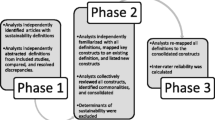Abstract
Fidelity scales have become an accepted part of intervention research. Initially, fidelity scales focused on critical components of an intervention. In this paper we argue that the next generation of fidelity scales should include key process variables such as choice. Since choice is an essential element in all empowerment and recovery driven intervention models, a fidelity scale for an enhanced version of the Individual Placement and Support (IPS) supported employment model that incorporates choice as a fundamental component was developed as part of a SAMHSA community action grant. The process for developing the choice component and the dimensions measured are also described.
Similar content being viewed by others
REFERENCES
Bond, G.R. (1998). Principles of the Individual Placement and Support Model: Empirical Support. Psychiatric Rehabilitation Journal, 22(1), 11–23.
Bond, G.R., Becker, D.R., Drake, R.E., Vogler, K.M. (1997). A fidelity scale for the Individual Placement and Support model of supported employment. Rehabilitation Counseling Bulletin, 40(4), 265–284.
Bond, G.R., McGrew, J.H. & Fekete, D.M. (1995). Assertive outreach for frequent users of psychiatric hospitals: a meta-analysis. Journal of Mental Health Administration, 22, 4–16.
Bond, G.R., Picone, J., Mauer, B., Fishbein, S., & Stout, R. (1999) The Quality of Supported Employment Implementation Scale. In G. Revell, K.J. Inge, D. Mank, & P. Wehman (Eds.), The impact of supported employment for people with significant disabilities: Preliminary findings from the National Supported Employment Consortium. Richmond, VA: Virginia Commonwealth University.
Carling, P.J. (1995). Return to community: Building support systems for people with psychiatric disabilities. New York: The Guilford Press.
Drake, R.E. (1998). A Brief History of the Individual Placement and Support Model. Psychiatric Rehabilitation Journal, 22(1), 3–7.
Drake, R.E., Becker, D.R., Clark, R.E., & Mueser, K.T. (1999). Research on the Individual Placement and Support model of Supported Employment. Psychiatric Quarterly, 70, 289–301.
Drake, R.E., McHugo, G.J., Becker, D.R., Anthony, W.A., & Clark, R.E. (1996). The NewHampshire Study of Supported Employment for people with severe mental illness. Journal of Consulting and Clinical Psychology, 64, 391–399.
McGrew, J.H., Bond, G.R., Dietzen, L., Salyers, M. (1994). Measuring the fidelity of implementation of a mental health program model. Journal of Counseling and Clinical Psychology, 62(4), 670–678.
McHugo, G.J., Drake, R.E., Teague, G.B., Xie, H. (1999). Fidelity to assertive community treatment and client outcomes in New Hampshire dual disorders study. Psychiatric Services, 50(6), 818–824.
Monahan, J., Lidz, C.W., Hoge, S.K., Mulvey, E.P., Eisenberg, M.M., Rothe, L. H., Gardner, W.P. & Bennett, N. (1999). Coercion in the provision of mental health services: The MacArthur Studies. Research in Community and Mental Health, 10, 13–30.
National Association of State Mental Health Program Directors (NASMHP). (1989). Position paper on consumer contributions to mental health service delivery systems. Alexandria, VA: Author.
National Council on Disability (2000). Executive Summary, From Privileges to Rights: People Labeled with Psychiatric Disabilities Speak for Themselves. Washington, DC: Retrieved January 27, 2000 from the World Wide Web: http://www.ncd.gov/publications/privileges.html
Nikkel, R. & Paulson, R. (1998). Phase I: Planning and Implementing an IPS??Program. Grant Application for CMHS Community Action Grant SM52481–01.
Rapp, C.A. & Poertner, J. (1992). Social administration: a client-centered approach. New York: Longman.
Sengupta, A., Drake, R.E. & McHugo, G.J. (1998). The relationship between substance use disorder and vocational functioning among people with severe mental illness. Psychiatric Rehabilitation Journal, 22(1), 41–45.
Teague, G.B., Bond, G.R., & Drake, R.E. (1998). Program fidelity and Assertive Community Treatment: Development and use of a measure. American Journal of Orthopsychiatry, 68, 216–232.
Witheridge, T.F. (1991). The “active ingredients” of assertive outreach. New Directions for Mental Health Services, 52, 47–64.
Author information
Authors and Affiliations
Rights and permissions
About this article
Cite this article
Paulson, R.I., Post, R.L., Herinckx, H.A. et al. Beyond Components: Using Fidelity Scales to Measure and Assure Choice in Program Implementation and Quality Assurance. Community Ment Health J 38, 119–128 (2002). https://doi.org/10.1023/A:1014591020400
Issue Date:
DOI: https://doi.org/10.1023/A:1014591020400




